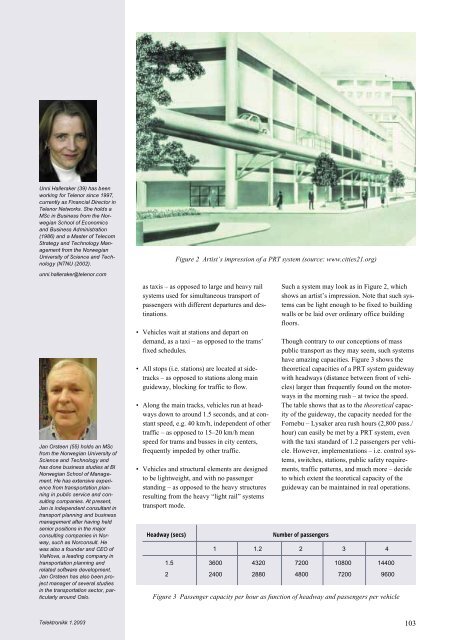Intelligent Transport Systems - Telenor
Intelligent Transport Systems - Telenor
Intelligent Transport Systems - Telenor
You also want an ePaper? Increase the reach of your titles
YUMPU automatically turns print PDFs into web optimized ePapers that Google loves.
Unni Halleraker (39) has been<br />
working for <strong>Telenor</strong> since 1997,<br />
currently as Financial Director in<br />
<strong>Telenor</strong> Networks. She holds a<br />
MSc in Business from the Norwegian<br />
School of Economics<br />
and Business Administration<br />
(1986) and a Master of Telecom<br />
Strategy and Technology Management<br />
from the Norwegian<br />
University of Science and Technology<br />
(NTNU (2002).<br />
unni.halleraker@telenor.com<br />
Jan Orsteen (55) holds an MSc<br />
from the Norwegian University of<br />
Science and Technology and<br />
has done business studies at BI<br />
Norwegian School of Management.<br />
He has extensive experience<br />
from transportation planning<br />
in public service and consulting<br />
companies. At present,<br />
Jan is independent consultant in<br />
transport planning and business<br />
management after having held<br />
senior positions in the major<br />
consulting companies in Norway,<br />
such as Norconsult. He<br />
was also a founder and CEO of<br />
ViaNova, a leading company in<br />
transportation planning and<br />
related software development.<br />
Jan Orsteen has also been project<br />
manager of several studies<br />
in the transportation sector, particularly<br />
around Oslo.<br />
Telektronikk 1.2003<br />
Figure 2 Artist’s impression of a PRT system (source: www.cities21.org)<br />
as taxis – as opposed to large and heavy rail<br />
systems used for simultaneous transport of<br />
passengers with different departures and destinations.<br />
• Vehicles wait at stations and depart on<br />
demand, as a taxi – as opposed to the trams’<br />
fixed schedules.<br />
• All stops (i.e. stations) are located at sidetracks<br />
– as opposed to stations along main<br />
guideway, blocking for traffic to flow.<br />
• Along the main tracks, vehicles run at headways<br />
down to around 1.5 seconds, and at constant<br />
speed, e.g. 40 km/h, independent of other<br />
traffic – as opposed to 15–20 km/h mean<br />
speed for trams and busses in city centers,<br />
frequently impeded by other traffic.<br />
• Vehicles and structural elements are designed<br />
to be lightweight, and with no passenger<br />
standing – as opposed to the heavy structures<br />
resulting from the heavy “light rail” systems<br />
transport mode.<br />
Headway (secs) Number of passengers<br />
Such a system may look as in Figure 2, which<br />
shows an artist’s impression. Note that such systems<br />
can be light enough to be fixed to building<br />
walls or be laid over ordinary office building<br />
floors.<br />
Though contrary to our conceptions of mass<br />
public transport as they may seem, such systems<br />
have amazing capacities. Figure 3 shows the<br />
theoretical capacities of a PRT system guideway<br />
with headways (distance between front of vehicles)<br />
larger than frequently found on the motorways<br />
in the morning rush – at twice the speed.<br />
The table shows that as to the theoretical capacity<br />
of the guideway, the capacity needed for the<br />
Fornebu – Lysaker area rush hours (2,800 pass./<br />
hour) can easily be met by a PRT system, even<br />
with the taxi standard of 1.2 passengers per vehicle.<br />
However, implementations – i.e. control systems,<br />
switches, stations, public safety requirements,<br />
traffic patterns, and much more – decide<br />
to which extent the teoretical capacity of the<br />
guideway can be maintained in real operations.<br />
1 1.2 2 3 4<br />
1.5 3600 4320 7200 10800 14400<br />
2 2400 2880 4800 7200 9600<br />
Figure 3 Passenger capacity per hour as function of headway and passengers per vehicle<br />
103
















